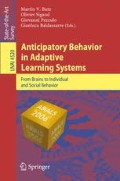Abstract
Regardless of complex, unknown, and dynamically-changing environments, living creatures can recognize situated environments and behave adaptively in real-time. However, it is impossible to prepare optimal motion trajectories with respect to every possible situations in advance. The key concept for realizing the environment cognition and motor adaptation is a context-based elicitation of constraints which are canalizing well-suited sensorimotor coordination. For this aim, in this study, we propose a polymorphic neural networks model called CTRNN+NM (CTRNN with neuromodulatory bias). The proposed model is applied to two dimensional arm-reaching movement control under various viscous force fields. The parameters of the networks are optimized using genetic algorithms. Simulation results indicate that the proposed model inherits high robustness even though it is situated in unexperienced environments.
Access this chapter
Tax calculation will be finalised at checkout
Purchases are for personal use only
Preview
Unable to display preview. Download preview PDF.
References
Beer, R.D.: Dynamical approaches to cognitive science. Trend in Cognitive Sciences 4-3, 91–99 (2000)
Bernstein, N.: The Coordination and Regulation of Movements. Pergamon, Oxford (1967)
Di Paolo, E.A.: Homeostatic adaptation to inversion of the visual field and other sensorimotor disruptions. From animals to animat 6, pp. 440–449. MIT Press, Cambridge (2000)
Eggenberger, P., Ishiguro, A., Tokura, S., Kondo, T., Uchikawa, Y.: Toward Seamless Transfer from Simulated to Real Worlds: A Dynamically-Rearranging Neural Network Approach. In: Demiris, J., Wyatt, J.C. (eds.) Advances in Robot Learning. LNCS (LNAI), vol. 1812, pp. 44–60. Springer, Heidelberg (2000)
Getting, P.A., Dekin, M.S.: Tritonia swimming: A model system for integration within rhythmic motor systems. In: Selverston, A.I. (ed.) Model neural networks and behavior, pp. 3–20. Plenum Press, New York (1985)
Haken, H.: Principles of Brain Functioning. Springer-Verlag, Berlin Heidelberg (1996)
Hasselmo, M.: Neuromodulation and cortical function: modeling the physiological basis of behavior. Behavioral Brain Research 67, 1–27 (1995)
Husbands, P., Smith, T.M.C., Jakobi, N., O’Shea, M.: Better Living Through Chemistry: Evolving GasNets for Robot Control. Connection Science 10(3-4), 185–210 (1998)
Ishiguro, A., Fujii, A., Eggenberger, P.: Neuromodulated Control of Bipedal Locomotion Using a Polymorphic CPG Circuit. Adaptive Behavior 11-1, 7–17 (2003)
Karniel, A., Mussa-Ivaldi, F.A.: Sequence, time, or state representation: how does the motor control system adapt to variable environments? Biological Cybernetics 89-1, 10–21 (2003)
Kondo, T.: Evolutionary design and behavior analysis of neuromodulatory neural networks for mobile robots control. Applied Soft Computing, vol. 7-1, pp. 189–202. Elsevier, North-Holland, Amsterdam (2007)
Kondo,T., Ishiguro, A., Tokura, S., Uchikawa, Y., Eggenberger, P.: Realization of Robust Controllers in Evolutionary Robotics: A Dynamically-rearranging Neural Network Approach, In: Proceedings of the 1999 Congress of Evolutionary Computation, vol.1, pp. 366–373 (1999)
Marder, E., Thirumalai, V.: Cellular, synaptic and network effects of neuromodulation. Neural Networks 15, 479–493 (2002)
Meyrand, P., Simmers, J., Moulins, M.: Construction of a pattern-generating circuit with neurons of different networks. NATURE 351, 60–63 (1991)
Paine, R.W., Tani, J.: Motor primitive and sequence self-organization in a hierarchical recurrent neural network. Neural Networks 17, 1291–1309 (2004)
Poggio, T., Bizzi, E.: Generalization in vision and motor control Insight Review Articles. Nature 431, 768–774 (2004)
Schöner, G., Kelso, J.A.S.: Dynamic pattern generation in behavioral and neural systems. Science 239, 1513–1520 (1988)
Smith, R.: Open dynamics engine v0.5 user guide (2004), http://ode.org/
Smith, T.M.C., Husbands, P., Philippides, A., O’Shea, M.: Neuronal Plasticity and Temporal Adaptivity: GasNet Robot Control Networks. Adaptive Behavior 10(3–4), 161–183 (2002)
Tani, J.: Learning to generate articulated behavior through the bottom-up and the top-down interaction processes. Neural Networks 16, 11–23 (2003)
Thelen, E., Smith, L.B.: A Dynamic Systems Approach to the Development of Cognition and Action. MIT Press, Cambridge (1994)
Wolpert, D.M., Kawato, M.: Multiple paired forward and inverse models for motor control. Neural Networks 11, 1317–1329 (1998)
Author information
Authors and Affiliations
Editor information
Rights and permissions
Copyright information
© 2007 Springer-Verlag Berlin Heidelberg
About this paper
Cite this paper
Kondo, T., Ito, K. (2007). An Intrinsic Neuromodulation Model for Realizing Anticipatory Behavior in Reaching Movement under Unexperienced Force Fields. In: Butz, M.V., Sigaud, O., Pezzulo, G., Baldassarre, G. (eds) Anticipatory Behavior in Adaptive Learning Systems. ABiALS 2006. Lecture Notes in Computer Science(), vol 4520. Springer, Berlin, Heidelberg. https://doi.org/10.1007/978-3-540-74262-3_14
Download citation
DOI: https://doi.org/10.1007/978-3-540-74262-3_14
Publisher Name: Springer, Berlin, Heidelberg
Print ISBN: 978-3-540-74261-6
Online ISBN: 978-3-540-74262-3
eBook Packages: Computer ScienceComputer Science (R0)

